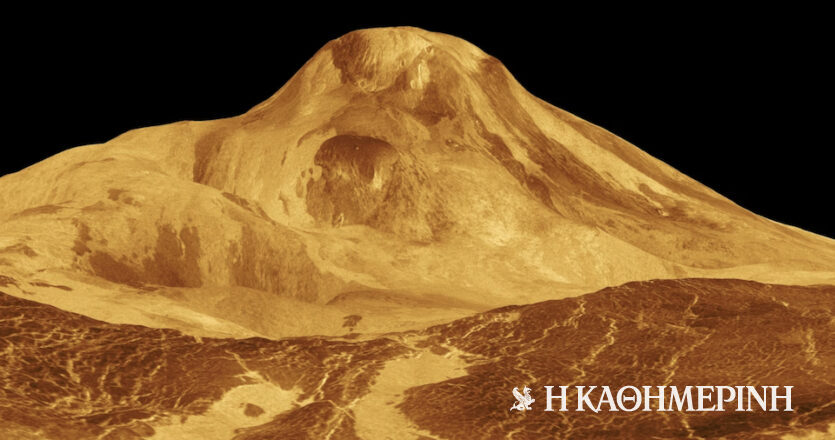
For about half a century, scientists had only hoped that they would one day see volcanoes erupt on Venus.
This nearby hot world is shrouded in dangerous clouds, but previous missions have revealed volcanic features of its surface. Now, thanks to data from the long-defunct spacecraft, scientists have found evidence of a physical structure on Venus that changes shape, expands, and appears to be overflowing with molten rock.
“I bet a lava lake erupted,” says Robert Herrick, a planetary scientist at the University of Alaska and one of the authors of the new study. According to research published in the journal Science, Herrick and a colleague identified a volcanic “vent” on the slope of the massive Maat Mons volcano from radar images taken by NASA’s Magellan spacecraft in 1991.
“This is one of the most compelling pieces of evidence we’ve seen,” asserts Stephen Kane, an astrophysicist at the University of California, Riverside, who was not involved in the work.
National Geographic comments: “The results stunned the scientific community.” Experts expected to find a volcanic eruption on Venus, but not before sending two spacecraft with advanced radar systems. Hacked Clouds – NASA Veritas and Europa Visualization – in the early 2030s.
Clues to current volcanic activity are valuable because the second planet from the Sun is very similar to Earth in size and composition. Important reserves of water that once existed – potential oceans – evaporated long ago “when the planet burned up during a mysterious cataclysm,” writes National Geographic. “Uncontrolled climate change caused by explosions of horrific proportions” remains the most likely cause. By understanding the current volcanic activity of Venus, scientists can learn more about the divergent paths of Earth and the burning world that resembles it.
“If you want to understand the only other Earth-sized world we’ll ever travel to anywhere in the universe, Venus is your only option,” says Paul Byrne, a planetary scientist at Washington University in St. Louis. He was not involved in the new study.
Hidden “hell”.
The opaque atmosphere of Venus hides the surface of the planet from observatories on Earth. A few spacecraft have come so close to alien landscapes, either by plunging through clouds and lasting an hour or two at most before exploding on the hot surface, or by circling the planet, “peeping” below the clouds using techniques like radar.
A swarm of Soviet spacecraft in the early 1980s revealed that Venus was almost entirely covered in volcanic structures – some resembling Earth and others clearly visible. Aliens. Hoping to map the planet’s features in unprecedented detail at the time, NASA’s Magellan spacecraft arrived in 1990 with radar instruments.
By circling the planet repeatedly and examining the same spots several times, scientists hoped to detect signs of volcanic activity. But there were problems. The low resolution of the radar means that any physical changes have to be large enough to be captured in images. And since the mission’s inception, Magellan’s orbit has narrowed with each orbit, resulting in fewer surface mappings on each successive trip around the planet.
Despite the challenges, 43% of the planet has been surveyed at least twice. But comparing multiple photos of the same volcano to look for changes also proved problematic, as the angle of each shot differed in many areas. In the decades that followed, no one was able to find an active volcano.
“Funnel” turns
Scientists have observed many indirect signs of active volcanism on Venus, including high concentrations of gases in the atmosphere associated with volcanic eruptions, new “suspicious” spots and unusual features in huge circular structures called coronas that indicate an underlying disturbance in the planet. magma. .
But the “Holy Grail” – a volcano spewing lava or a gushing river of molten rock – remained elusive.
2021 EnVision and VERITAS have been selected for future exploration of VenusBut Herrick was patient. Amid the pandemic, he went through old Magellan data and hand-aligned images of Venus’s volcanoes, looking for anything that might be considered unusual.
During one of these analyzes, Herrick examined Maat Mons. Named after the Egyptian goddess of truth and justice, it is the tallest volcano on the planet – and On one of its slopes, between February and October 1991, something changed. Within eight months, the material appears to have overflowed and the hole has expanded from 0.8 to 1.5 square miles, while a fresh stream of material seems to have moved down the slope.
Herrick discussed this with Scott Hensley, study co-author of NASA’s Gas Propulsion Laboratory, who agreed that something had moved.
The material in the natural channel could be rock debris from a landslide. It is also possible that the apparent “current” was there in February as well, but was not captured due to the angle of the shot.
But the most likely scenario is that in 1991 a huge volcanic eruption filled the bulging vent with lava, some of which spilled over the rim or escaped through a crack. “We can safely say that it has changed shape,” says Herrick. And when a volcano changes shape very dramatically on Earth, the root cause is always molten rock
I’m looking for the “heartbeat” of Venus
After a lot of circumstantial evidence, “this is the first time we’ve seen something change,” says Anna Gulcher, a planetary scientist at Caltech who was not involved in the work.
“I think they really saw what happened,” says Byrne of the University of Washington, who suspects the downstream change could be due to some subterranean movement, such as violent displacement of magma underground, rather than an explosion.
Scientists hope to answer a fundamental question: “What is the daily routine for volcanic activity on Venus?”
Volcanoes on Earth and Jupiter’s moon Io are constantly erupting. Mars erupts every few million years. Where does Venus rank in this spectrum?
The discovery indicates that the planet has strong volcanic activity similar to that of Earth. VERITAS and EnVision are set to answer that question, but until then, this study will encourage scientists to study ancient Magellanic records in hopes of finding another active volcano on Venus.
Source: National Geographic
⇒ News of the day
follow her kathimerini.gr on Google News And be the first to know all the news
Find out the latest news from Greece and the world on kathimerini.gr

“Total alcohol fanatic. Coffee junkie. Amateur twitter evangelist. Wannabe zombie enthusiast.”





More Stories
Steam closes a loophole that allows players to get their money back
After 14 years, Apple will do the unheard of on iPads
NASA: Stunning images of lava lakes and mountains on Jupiter's moon Io